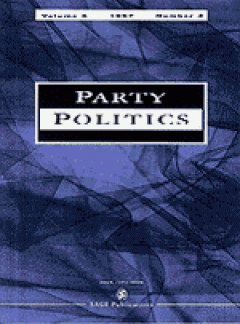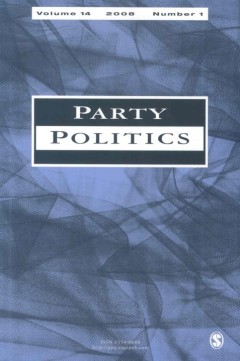Filter by

Party Direction: The Italian Case in Comparative Perspective
The purpose of this article is to further our understanding of the directional nature of left—right scores. I suggest that a party’s ability to modify its perceived position is conditional on whether parties adopt their manifestos to alter their perceived position and on whether voters are persuaded by parties’ attempts to relocate in political space. As voters’ knowledge of political parties i…
- Edition
- Vol. 16, No. 1, Jan. 2010. pp. 51-67
- ISBN/ISSN
- 13540688
- Collation
- -
- Series Title
- Party Politics
- Call Number
- -

Where Are the Disgruntled Voters?: Voter—Party Relations under Cartelizing …
Katz and Mair’s provocative Cartel Party argument continues to create fertile ground for debate. This article contributes to under-explored areas of this debate by enhancing the theoretical and empirical understanding of the change in the relationship between parties and voters resulting from the introduction of the cartelizing condition of public funding. To this end, the article examines vote…
- Edition
- Vol. 16, No. 1, Jan. 2010. pp. 29-49
- ISBN/ISSN
- 13540688
- Collation
- -
- Series Title
- Party Politics
- Call Number
- -

Get the Party Started: Development of Political Party Legislative Dynamics in…
In this article, we investigate the effect of political parties on legislative behaviour. We compile and analyse a unique dataset of all roll-call votes for all the sessions of the Irish Free State Seanad (the Upper Chamber in the legislature, 1922—36). The development of legislative parties inside the Irish Seanad led to the formation of cohesive voting blocs after 1928. This caused dramatic s…
- Edition
- Vol. 16, No. 1, Jan. 2010. pp. 89-110
- ISBN/ISSN
- 13540688
- Collation
- -
- Series Title
- Party Politics
- Call Number
- -

Parties’ Responses to Economic Globalization: What is Left for the Left and…
Do parties adjust their economic policy positions in response to the international economy? I explore how international economic conditions affect Western Europe’s welfare states by quantitatively analysing parties’ ideological dynamics over time. Considering the convergence—divergence argument of the globalization literature, I evaluate the hypothesis that economic openness motivates parties t…
- Edition
- Vol. 16, No. 1, Jan. 2010. pp. 5-27
- ISBN/ISSN
- 13540688
- Collation
- -
- Series Title
- Party Politics
- Call Number
- -

The Moderation Theory Revisited: The Case of Islamic Political Actors
An influential political science literature argues that integration of radical political parties within the political system leads to their moderation. These parties trade off their ideological platforms for electoral viability and political legality. Radicals become moderates through strategic interests. In this article, I revisit this thesis and apply it to the Islamic political actors in Ira…
- Edition
- Vol. 16, No. 1, Jan. 2010. pp. 69-88
- ISBN/ISSN
- 13540688
- Collation
- -
- Series Title
- Party Politics
- Call Number
- -

Effect of Local Ties On Electoral Success and Parliamentary Behaviour: The Ca…
The growing literature on personal vote assumes that candidates with strong local ties should be more successful electorally and more likely to break party unity in parliament. Using unique data from Estonia on candidates’ personal vote-earning attributes, such as local birthplace and local-level political experience, this research note offers the first direct test of both of these assumptions.…
- Edition
- Vol. 16, No. 2, March 2010. pp. 215-235
- ISBN/ISSN
- 13540688
- Collation
- -
- Series Title
- Party Politics
- Call Number
- -

Methodological Issues in the Study of New Parties’ Entry and Electoral Success
Studies of the emergence and electoral success of new parties frequently suffer from conceptual and methodological flaws: effects of electoral institutions that primarily operate at the level of the constituencies are specified at the national level; central explanatory variables such as electoral demands and competitors’ responses are measured with crude proxies; the interplay of formation and…
- Edition
- Vol. 16, No. 2, March 2010. pp. 147-170
- ISBN/ISSN
- 13540688
- Collation
- -
- Series Title
- Party Politics
- Call Number
- -

The Effective Number of Parties: A New Approach
The Laakso—Taagepera index of the effective number of parties, while satisfying most of the requirements of this aggregate quantity, tends to produce unrealistically high scores for party constellations in which the shares of the largest parties exceed 50 percent, and can produce misleading results in several other situations. After reviewing the structural properties of the Laakso—Taagepera in…
- Edition
- Vol. 16, No. 2, March 2010. pp. 171-192
- ISBN/ISSN
- 13540688
- Collation
- -
- Series Title
- Party Politics
- Call Number
- -

Explaining Participation in Intra-Party Elections: Evidence from Belgian Poli…
This article focuses on the participation of party members in intra-party elections and on explanations for this behaviour. The number of intra-party elections is increasing, but their study remains an under-researched phenomenon in contemporary party politics. I test whether participation theories applicable to participation in society also obtain in intra-party elections. The theories tested …
- Edition
- Vol. 16, No. 2, March 2010. pp. 237-259
- ISBN/ISSN
- 13540688
- Collation
- -
- Series Title
- Party Politics
- Call Number
- -

Parsimonious Model for Predicting Mean Cabinet Duration On the Basis of Elect…
This study joins two existing logical models and tests the resulting predictions of mean cabinet duration (C). One of these models predicts C based on effective number of parties (N): C = k/N2, where k is found to be around 42 years. The other predicts N on the basis of number of seats in the assembly (S) and district magnitude (M). The new combined model leads to a prediction for the mean cab…
- Edition
- Vol. 16, No. 2, March 2010. pp. 261-281
- ISBN/ISSN
- 13540688
- Collation
- -
- Series Title
- Party Politics
- Call Number
- -

Fear of the Political Consultant: Campaign Professionals and New Technology i…
In the digital age it is claimed that political parties do not have the capacity to deliver the advanced technical services that modern campaigning demands, and that much of the campaign work is better handled by political consultants. Based on the ‘hybridization’ view of campaign change, the article explores to what extent ICTs increase the need for campaign professionals, and what type of pro…
- Edition
- Vol. 16, No. 2, March 2010. pp. 193-214
- ISBN/ISSN
- 13540688
- Collation
- -
- Series Title
- Party Politics
- Call Number
- -

A Man for All Seasons: Partisan Constraints on U.S. Senate Majority Leaders
In this article, I examine the roll-call voting behaviour of U.S. Senate Majority Leaders, finding that Leaders generally locate around the ideological mean and median of their party at selection and at the beginning of their tenure but move toward the partisan extreme as their leadership progresses. Statistical analysis links this movement to size of majority; that is, as their partisan majori…
- Edition
- Vol. 16 no. 3, May 2010, pp. 323-346
- ISBN/ISSN
- 13540688
- Collation
- -
- Series Title
- Party Politics
- Call Number
- -

Experts’ Political Preferences and Their Impact on Ideological Bias: An Unf…
Expert surveys have become increasingly popular among political scientists. One of the problems of using surveys (of any sort) to estimate party positions is that respondents can be influenced by their subjective political views. As a consequence, experts may give biased responses, and such (ideological) bias may affect certain parties more than others. In this paper, we use the latest expert s…
- Edition
- Vol. 16 no. 3, May 2010. pp. 299-321
- ISBN/ISSN
- 13540688
- Collation
- -
- Series Title
- Party Politics
- Call Number
- -

Bringing Parties Into Parliament: The Development of Parliamentary Activities…
The literature on Western European parliaments has long pointed to an increase in non-legislative activities, including questions to the minister and interpellations; however, it has struggled to explain this development. This paper argues that the explanation ought to be sought in the increased importance of issue competition among political parties in Western Europe. Political parties are inc…
- Edition
- Vol. 16 no. 3 May 2010, pp. 347-369
- ISBN/ISSN
- 13540688
- Collation
- -
- Series Title
- Party Politics
- Call Number
- -

Electoral Reform and Political Pluralism in Local Government
Electoral reform to a system of direct election of mayors has recently been promoted in a number of countries. It has been advocated as a way of strengthening local government, improving governance, and increasing accountability. However, studies supporting such a change have been detached from research on electoral systems and electoral reform. This article examines the consequences of a shift…
- Edition
- Vol. 16 no. 3 May 2010, pp. 394-413
- ISBN/ISSN
- 13540688
- Collation
- -
- Series Title
- Party Politics
- Call Number
- -

Toward a Two-Party System or Two Party Systems?: Patterns of Competition in J…
This article examines whether electoral reform in Japan replacing a single non-transferable vote (SNTV) system with a parallel mixed system has led to two-party competition in single-member districts (SMDs) in House of Representative elections from 1996 to 2005. While nationwide figures suggest declining numbers of effective candidates and losers, distinguishing SMDs by levels of urbanization r…
- Edition
- Vol. 16 no. 3 May 2010 , pp. 370-393
- ISBN/ISSN
- 13540688
- Collation
- -
- Series Title
- Party Politics
- Call Number
- -

Congressional Parties and the Mobilization of Leadership PAC Contributions
Traditionally, observers have characterized leadership political action committees (LPACs) as tools used by political entrepreneurs to build personal coalitions supporting their power and policy goals. We argue that political context — namely, competition for control of the House and the advancement structures created by the parties — shapes the way House members use LPAC contributions to advan…
- Edition
- Vol. 16 no. 4 July 2010, pp. 451-475
- ISBN/ISSN
- 13540688
- Collation
- -
- Series Title
- Party Politics
- Call Number
- -

Party Aggregation in India: A State Level Analysis
Existing research on party aggregation focuses on the national level, relating it to changes in the federal distribution of powers. I argue that party aggregation also affects sub-national party systems, and therefore that study of party aggregation needs to extend beyond the national level. A comparative analysis reveals that party aggregation at the Indian sub-national (state) level does not …
- Edition
- Vol. 16 no. 4 July 2010 pp. 477-496
- ISBN/ISSN
- 13540688
- Collation
- -
- Series Title
- Party Politics
- Call Number
- -

Euroscepticism and the Emergence of Political Parties in Poland
One of the most interesting features of the 2003 Polish referendum on European Union (EU) membership was the strong link between voting behaviour in the 2003 referendum and voting behaviour in the 2001 Polish parliamentary election. In this article, we test two competing mechanisms that could account for this finding: a responsible party model, whereby citizens’ attitudes towards EU membership …
- Edition
- Vol. 16 no. 4 July 2010 pp. 523-548
- ISBN/ISSN
- 13540688
- Collation
- -
- Series Title
- Party Politics
- Call Number
- -

Measuring Parties’ Ideological Positions With Manifesto Data: A Critical Ev…
Within the rapidly growing literature on positioning political parties along policy dimensions, the rich data series collected by the Comparative Manifestos Project (CMP) has been widely considered as the most systematic and objective source of information. For estimating parties’ positions on the Left—Right dimension alone, several different methods have been proposed which make use of the CMP…
- Edition
- Vol. 16 no. 4 July 2010, pp. 427-450
- ISBN/ISSN
- 13540688
- Collation
- -
- Series Title
- Party Politics
- Call Number
- -
 Computer Science, Information & General Works
Computer Science, Information & General Works  Philosophy & Psychology
Philosophy & Psychology  Religion
Religion  Social Sciences
Social Sciences  Language
Language  Pure Science
Pure Science  Applied Sciences
Applied Sciences  Art & Recreation
Art & Recreation  Literature
Literature  History & Geography
History & Geography